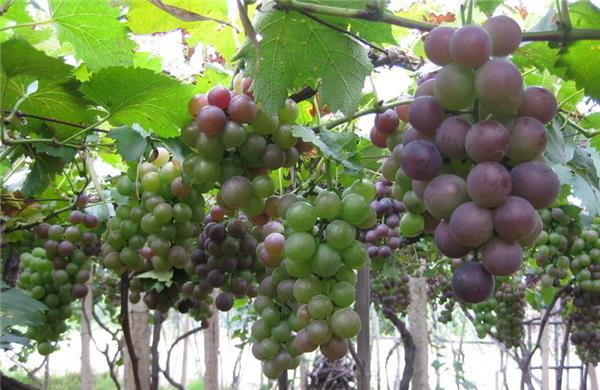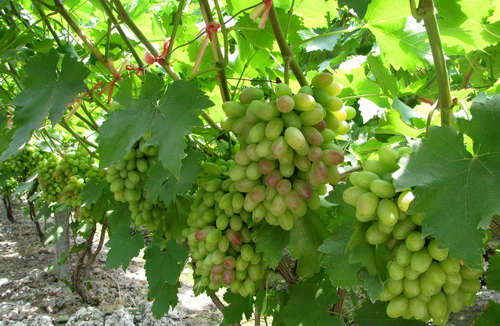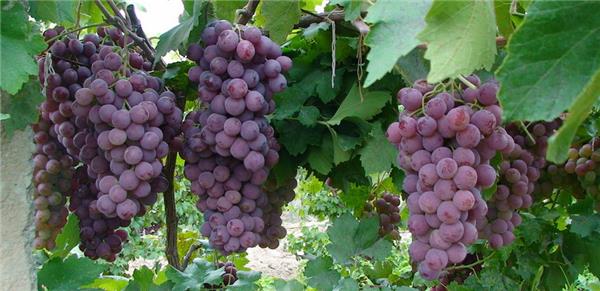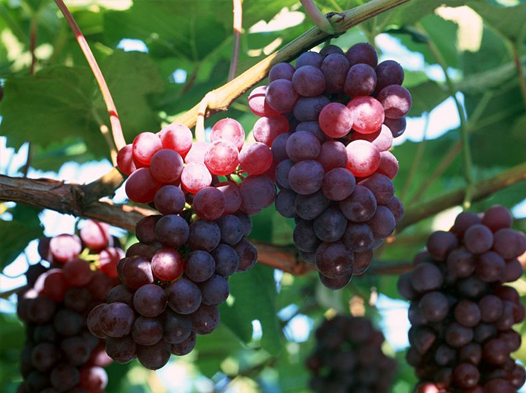Detailed explanation of grape cultivation techniques
Grape cultivation has a long history, but now there are fewer and fewer families with courtyards. Potted grapes are what many flower friends want to try, but because vines are relatively large vines, many flower friends who grow grapes in pots are not very confident. What are the planting techniques of potted grapes? How many methods are there for the cultivation of grape seedlings?

How many methods are there for the cultivation of grape seedlings?
There are usually two ways to cultivate grape seedlings: one is asexual culture, that is, nutritional culture; the other is sexual culture, that is, seed culture.
Vegetative culture is a method of using part of the organs of grape plants, mainly using stems to culture and cultivate seedlings. Its advantage is that the new plant has little variation, can maintain the variety characteristics of the mother plant, and can be cultured many times in a year. The plants cultivated by this method have the advantages of early formation, fast growth and early fruiting period, so they are widely used in production. The methods of asexual culture include hardwood cuttings, green branches cuttings, striping, grafting and tissue culture of stem tips and stem segments, among which hardwood cuttings and grafting are widely used, which is also a more traditional method. Tissue culture is a modern breeding method with large investment and high requirements for facilities and technology.
Sexual culture is a method of using seeds to produce new plants. it is the result of sexual hybridization and genetic recombination. The genetic variability of the new plants is large, so it is difficult to maintain the characteristics of the original varieties, and this method is not used to raise seedlings of good varieties. Seed culture is usually used in traditional grape breeding, hybrid seeds are obtained by hybridization, and new varieties with good characters are screened from a large number of seedlings. This method is often used for the breeding of new grape varieties, but it is labor-consuming and time-consuming, and the breeding cycle is long, so it is not suitable for general seedling culture.

The construction of grapes (double cross V-frame)
The main pole, top reinforcement, pile line and ground anchor stone of the double cross V-shaped frame are all set up the same as the single hedge frame. In the first year, a piece of iron wire (monofilament) is drawn longitudinally on the cement pole 80 centimeters above the ground to facilitate the binding of small bamboos. Before the grape sprouts in the second year, on the other side of the cement pole, pull a single wire parallel to the wire drawn in the first year. At the same time, two beams are set up on the cement pole, the first one is fixed 120 centimeters above the ground with a hoop, and the length of the beam is 40-50 centimeters. Set up a second beam 160 cm above the ground, with a length of 80-100 cm. The crossbeam is made of 3 × 3 angle steel, one side of the cross angle steel is equally divided into two holes, which is used for fixing the hoop, and each end is punched with a small hole, the size of the small eye can pass through the wire, it should not be too large, after the cross angle steel is finished, it is brushed with anti-corrosion paint, and then fixed to the cement rod to prevent corrosion, galvanized anti-corrosion is better. After the crossbeam is fixed, a piece of iron wire is drawn through the middle of the eyes at both ends, and after one end is fixed, the other end is tightened with a tightening machine and then fixed. When tightening, both ends of the crossbeam should be tightened with two tensioners at the same time to balance the power. A total of seven wires are drawn on such a row of cement rods. In the future, each grape will have four fruit mother branches, two on each side, tied horizontally to the two wires at the bottom, and the branches will be gradually tied to the wire at both ends of the beam, forming a 45-degree V-shaped, so it is called a double cross V-shaped frame. And form the cultivation pattern of ventilation zone below, fruit zone in the middle and photosynthetic zone above.
Prevention and Control of potted Grape
Prevent bird damage (when the grape is about to ripen, the bird picks the ripe grape): making newspaper bagging grape has a good effect, not only reduce sunburn, prevent bacterial infection, prevent bird damage, and make bags convenient. Each large newspaper can be made into 4 paper bags with a value of less than 1 point. The bag is 27 km long and 20 km wide. Take 6 mi 8 km thin wire for spare. Roll the side of the bag with a sewing machine, nail the lower mouth to the middle with a stapler, and leave 6 square meters of air holes on each side. If it is used in orchards with high temperature and humidity in summer, it can be unsealed to enhance the performance of moisture drainage. Bagging the whole ear, thinning grains, spraying fungicides, insecticides and available calcium before bagging. Bagging time should be in the morning after the dew dries to the evening, pay attention to the noon bagging as far as possible to avoid the highest temperature and direct sunlight. The bag picking time should be determined according to the variety and the market time. For the mid-early maturing and easy coloring varieties, the bag should be removed 10 days before harvest, and for the late-maturing varieties, the bag should be removed 10 minutes and 15 days before harvest. After picking the bag, you should pick the leaves and turn the fruit.

Disease control: before the grape bud eyes germinate, spray 50-100 times of Solibar or spray 3 Baumedo-5 Baomedo stone sulfur mixture (0.3% washing powder is more effective). For orchards with serious diseases such as fruit rot last year, lime should be sprinkled on the ground before the disease occurs, or 50% carbendazim 500-600 times liquid should be sprayed under the shelf to control the initial infection source from the soil overwintering.
Give priority to prevention, spray in time: for drugs with a residual period of 17 Mel for 21 days, spray once every 15 days. If it rains in the middle, shorten the next spraying days as appropriate. If there is heavy rain after spraying, it will be sprayed again after it clears up. If the adjacent two kinds of drugs are alkaline or acidic respectively, the interval time should be strictly controlled to prevent the neutralization of the two kinds of acid and aniline.
See the initial onset of the disease, timely treatment: continuous rain, high temperature and humidity, the most susceptible to the disease, must be observed every day, see the initial onset of the disease namely symptomatic spray. Downy mildew can be prevented by using 70% Kobo 600 times solution, 80% ethylphosphoaluminum 300 times solution or lRanger 0.7 Vol 180 times Bordeaux solution.
Bordeaux liquid is the main solution, suitable for other drugs: this method is very effective in disease prevention. Spray one time before blooming, one time after blossom, one time, two times, one time, one time, one time If the occurrence of white rot, anthrax, then symptomatic spray. Most of these drugs are acidic and the interval time should be strictly controlled with Bordeaux solution.
Clear the garden at the right time to curb the spread of the disease: if a disease occurs, the disease is most likely to spread because of high temperature and humidity. The garden should be cleared at any time. Remove the diseased leaves, branches and fruits from the garden, bury them or burn them. Remove weeds in the garden in time, often wash scissors and disinfect them when cutting off diseased branches and fruits to prevent cross-infection.

Relationship between Root characteristics and fertilization of Grape
The backbone root of grape mainly transports nutrients and water, and it is also an important place for nutrient storage, which accounts for 70% and 85% of all nutrients in the tree. The root growth of grape has two peaks in a year. The first peak is from May to June, and the second peak is from September to October. In production, this characteristic is often used to apply base fertilizer in late autumn to promote the growth and development of root system.
The most suitable soil for grape root growth is fertile and soft sandy loam, which requires that PH is between 5-8 and PH6-7 is the most suitable. Lime and organic fertilizer should be applied to improve the PH of red-yellow soil hilly wasteland in the south of the Yangtze River, and gypsum and organic fertilizer should be applied to improve the yellow leaf disease due to lack of trace elements when PH is 8.3-8.7 in saline-alkali soil or calcareous soil. Grape roots also have certain requirements for soil moisture, and 60-70% of the field capacity is the most suitable. Too little and too much water will affect the yield, quality and disease of grape.
Conventional fertilization methods for high-yield grapes
According to the nutrient content of NRV 0.3-0.55kg, P2O5:0.13-0.28kg and K2O:0.28-0.64kg absorbed from the soil by each 100kg fruit, the yield of 1800-2000kg grape per mu was put into circle fertilizer 5000-6000kg per mu per year. Each plant was fertilized with 100-120kg fertilizer or 25-40kg poultry manure per year. Available fertilizer 1-2kg.
Application method of Tianyun Fertilizer
1. Fruit trees apply Tianyuan400-600kg 7.5% powder fertilizer per mu per year or 10-12kg per plant per year. For young trees, the use is halved.
The amount of basal fertilizer used from September to October was 4-5kg per plant, the first topdressing in April was 10-15 days before flowering, the second topdressing was 1-2 kg; per plant in May-June, and 4-6kg was applied per plant during the fruit expansion period.
3. Application method: dig the disc ditch or square hole with a depth of 40-60cm, irrigate enough water according to the amount of fertilizer, and then cover the soil to keep moisture. Be careful not to mix with germicidal pesticides.
Apply more organic fertilizer to improve the soil and improve the soil conditions of grape growth, so as to lay a good foundation for sustainable high yield and high quality.
Give priority to prevention, spray in time: for drugs with a residual period of 17 Mel for 21 days, spray once every 15 days. If it rains in the middle, shorten the next spraying days as appropriate. If there is heavy rain after spraying, it will be sprayed again after it clears up. If the adjacent two kinds of drugs are alkaline or acidic respectively, the interval time should be strictly controlled to prevent the neutralization of the two kinds of acid and aniline.
See the initial onset of the disease, timely treatment: continuous rain, high temperature and humidity, the most susceptible to the disease, must be observed every day, see the initial onset of the disease namely symptomatic spray. Downy mildew can be prevented by using 70% Kobo 600 times solution, 80% ethylphosphoaluminum 300 times solution or lRanger 0.7 Vol 180 times Bordeaux solution.
Bordeaux liquid is the main solution, suitable for other drugs: this method is very effective in disease prevention. Spray one time before blooming, one time after blossom, one time, two times, one time, one time, one time If the occurrence of white rot, anthrax, then symptomatic spray. Most of these drugs are acidic and the interval time should be strictly controlled with Bordeaux solution.
Clear the garden at the right time to curb the spread of the disease: if a disease occurs, the disease is most likely to spread because of high temperature and humidity. The garden should be cleared at any time. Remove the diseased leaves, branches and fruits from the garden, bury them or burn them. Remove weeds in the garden in time, often wash scissors and disinfect them when cutting off diseased branches and fruits to prevent cross-infection.

Relationship between Root characteristics and fertilization of Grape
The backbone root of grape mainly transports nutrients and water, and it is also an important place for nutrient storage, which accounts for 70% and 85% of all nutrients in the tree. The root growth of grape has two peaks in a year. The first peak is from May to June, and the second peak is from September to October. In production, this characteristic is often used to apply base fertilizer in late autumn to promote the growth and development of root system.
The most suitable soil for grape root growth is fertile and soft sandy loam, which requires that PH is between 5-8 and PH6-7 is the most suitable. Lime and organic fertilizer should be applied to improve the PH of red-yellow soil hilly wasteland in the south of the Yangtze River, and gypsum and organic fertilizer should be applied to improve the yellow leaf disease due to lack of trace elements when PH is 8.3-8.7 in saline-alkali soil or calcareous soil. Grape roots also have certain requirements for soil moisture, and 60-70% of the field capacity is the most suitable. Too little and too much water will affect the yield, quality and disease of grape.
Conventional fertilization methods for high-yield grapes
According to the nutrient content of NRV 0.3-0.55kg, P2O5:0.13-0.28kg and K2O:0.28-0.64kg absorbed from the soil by each 100kg fruit, the yield of 1800-2000kg grape per mu was put into circle fertilizer 5000-6000kg per mu per year. Each plant was fertilized with 100-120kg fertilizer or 25-40kg poultry manure per year. Available fertilizer 1-2kg.
Application method of Tianyun Fertilizer
1. Fruit trees apply Tianyuan400-600kg 7.5% powder fertilizer per mu per year or 10-12kg per plant per year. For young trees, the use is halved.
The amount of basal fertilizer used from September to October was 4-5kg per plant, the first topdressing in April was 10-15 days before flowering, the second topdressing was 1-2 kg; per plant in May-June, and 4-6kg was applied per plant during the fruit expansion period.
3. Application method: dig the disc ditch or square hole with a depth of 40-60cm, irrigate enough water according to the amount of fertilizer, and then cover the soil to keep moisture. Be careful not to mix with germicidal pesticides.
Apply more organic fertilizer to improve the soil and improve the soil conditions of grape growth, so as to lay a good foundation for sustainable high yield and high quality.
- Prev

Morphological characteristics of Cinnamomum camphora what is the difference between Cinnamomum camphora and Cinnamomum camphora
Morphological characteristics of Cinnamomum camphora what is the difference between Cinnamomum camphora and Cinnamomum camphora
- Next

What are the varieties of cactus?
What are the varieties of cactus?
Related
- Wuhan Hospital Iron Tree Blooming Result Was Instantly Frightened by the Gardener Master
- Which variety of camellia is the most fragrant and best? Which one do you like best?
- What is the small blue coat, the breeding methods and matters needing attention of the succulent plant
- Dormancy time and maintenance management of succulent plants during dormancy
- Minas succulent how to raise, Minas succulent plant pictures
- What are the varieties of winter succulent plants
- How to raise succulent plants in twelve rolls? let's take a look at some experience of breeding twelve rolls.
- Attention should be paid to water control for succulent plants during dormant period (winter and summer)
- Watering experience of twelve rolls of succulent plants
- Techniques for fertilizing succulent plants. An article will let you know how to fertilize succulent plants.

